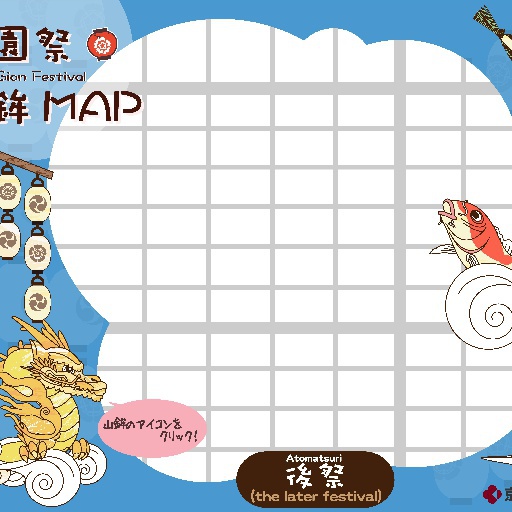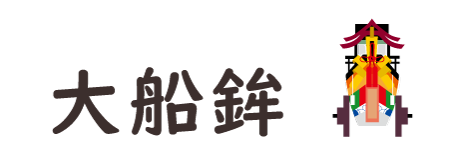Kyoto Gion Festival / Atomatsuri

Map of Kyoto Gion Festival / Atomatsuri Click a "Yamahoko" picture, then you can see the photo and the explanation.
All spots information
25 spots
 Shinmachi St.
Shinmachi St.
 Muromachi St.
Muromachi St.
 Nishinotoin St.
Nishinotoin St.
 Oike St.
Oike St.
 Takoyakushi St.
Takoyakushi St.
 Sanjo St.
Sanjo St.
 Nishikikoji St.
Nishikikoji St.
 Rokkaku St.
Rokkaku St.
 Aneyakouji St.
Aneyakouji St.
 Shijo St.
Shijo St.
 Ayanokoji St.
Ayanokoji St.
 祇園祭説明
祇園祭説明

Gion festival In 2009 the festival was registered as an Intangible Cultural Heritage by UNESCO. Originally, the Yamahoko float procession was considered to be the forerunner of "Mikoshi-togyo" or portable shrine parades. There are two processions: one that proceeds the Shinko-sai ritual called "Saki-matsuri," or the former festival, and the other that proceeds the Kanko-sai ritual called "Ato-matsuri" or the latter festival. Although Saki-matsuri and Ato-matsuri had been united due to consideration of traffic congestion and tourism promotion since the high economic growth period, it was decided to separate them again in order to restore their original style. In 2014, the Yamahoko float procession of Ato-matsuri was restored after nearly half a century. Assembly of the floats for Saki-matsuri begins around July 10, and "Hikizome," or first pulling of the floats, is performed around July 12. After the events of July 14, 15 and 16, called Yoiyoiyoiyama, Yoiyoiyama and Yoiyama respectively, the 23 Yamahoko floats of Saki-matsuri proceed through the main streets of Kyoto accompanied by festive music on July 17. On that evening the Shinko-sai ritual, where three portable shrines transporting the deities of Yasaka Shrine are carried to Otabisho in Shijo-Teramachi, is performed. On the day after the Yamahoko float procession of Saki-matsuri, assembly of the floats for Ato-matsuri begins. The days from July 21 to 23 are its Yoiyama period, and the Yamahoko float procession of Ato-matsuri is performed on July 24. "Hanagasa Junko" parade is also held on the same day. In the evening, the Kanko-sai ritual is held in which the portable shrines are returned to the shrine from Otabisho. Until the Saki-matsuri Yamahoko float procession = Residents, including women, can also take part in "Hikizome," which is held around July 12. Visitors can enjoy the Yama and Hoko floats illuminated by the light of lanterns in each float community until Yoiyama on July 16. Visitors can get "Chimaki," a talisman against evil, and lucky charms for academic achievement, success in life or other goals at each Yamahoko float. The Saki-matsuri Yamahoko float procession (July 17) = At 9:00 a.m., a total of 23 Yamahoko floats set off from near Shijo-Karasuma. After heading east on Shijo-dori Street, they go north on Kawaramachi-dori Street, and then west on Oike-dori Street. Highlights of the procession are "Shimenawa-giri," or a ritual in which Naginata Hoko's sacred child cuts a sacred rope at Shijo-Fuyacho, and "Tsuji-mawashi," the ninety-degree turn made by the floats at each intersection. Until the Ato-matsuri Yamahoko float procession = Preparation of floats for Ato-matsuri begins the day after the Yamahoko float procession of Saki-matsuri. As opening street stalls is restricted during Yoiyama, the authentic festival atmosphere can be enjoyed. Ato-matsuri Yamahoko float procession (July 24) = At 9:30 a.m., a total of ten Yamahoko floats set off from near Karasuma-Oike. They follow along the same course as Saki-matsuri, but in the reverse direction. Highlights are the restored O-Fune Hoko float and "Tsuji-mawashi" turns which are performed the opposite way of the turns during Saki-matsuri. The Hanagasa Junko parade, which had long been held in lieu of the Ato-matsuri procession prior to its restoration, proceeds through Oike-dori Street and Kawaramachi-dori Street, as if it were following Ato-matsuri procession. Copyright (c)2019 The Kyoto Shimbun Co.,Ltd. All rights reserved.
 鈴鹿山
鈴鹿山

Suzuka-yama(鈴鹿山) The old Tokaido route, which connected the old capital area with the eastern area, ran through Suzuka Yama. One of its chokepoints, Suzuka Toge had many steep paths. Due to this, the area has plenty of historical and notorious episodes as merchants were often attacked by gangs of robbers which may later have been transformed into the Oni, or ogres, of folklore. The Suzuka Yama float features the myth about the Goddess of Suzukayama, Suzuka Myojin (Seoritsuhime-no-Mikoto), who exterminated the Oni. The figure of the Goddess on the yama looks gallant in her Tate-eboshi (a headdress for men), holding a long Naginata or pole sword. The yama has a tapestry on the front, called Hyaku Sennin Tuzuranishiki Maekake, which depicts camels traveling in the desert. The Maekake tapestry was renewed in 1989 for the first time in 220 years. Copyright (c)2019 The Kyoto Shimbun Co.,Ltd. All rights reserved.
 役行者山
役行者山

Ennogyoja-yama(役行者山) The En-no-Gyoja-yama and the Suzuka Yama are from the northernmost Yamahoko-Cho (the towns that keep the floats). The main figure of the float is En-no-Gyoja who has been popular through the ages because he was a practitioner of Shugen-do as well as a doctor for the common folk. There are three figures on the yama; the figure of En-no-Gyoja is seated between the Hitokotonushi God and the Katsuragi Goddess who have the faces of Oni or ogres. The relationship among them is not known exactly, however, the float originates from the folklore that En-no-Gyoja used the Oni to build a bridge between Mt. Omine and Mt. Katsuragi. This yama is one of the largest floats as it has more figures than most on it. Also, only the En-no-Gyoja Yama has two vermilion-lacquered umbrellas. Copyright (c)2019 The Kyoto Shimbun Co.,Ltd. All rights reserved.
 北観音山
北観音山

Kitakannon-yama(北観音山) This float and Minami-Kannon Yama of the neighboring block had alternately participated in the procession every other year from the Onin-no-ran Battle in the 15th century until around 1864. No other yama or hoko floats participated biyearly in the procession. The images of "Yoryu Kannon" (the Goddess of Mercy) and "Idaten" (a guardian deity) are enshrined on the float. As it is not a hoko float, Kita Kannon Yama has "shin-matsu" (a pine tree) instead of a mast-like wooden pole called "shingi". The two pine trees are delivered from Narutaki, the northwestern area of Kyoto. Kita-Kannon Yama and Minami-Kannon Yama draw lots for the pine trees to decide which will belongs to which float. Copyright (c)2019 The Kyoto Shimbun Co.,Ltd. All rights reserved.
 八幡山
八幡山

Hachiman-yama(八幡山) It is a wonder that the Iwashimizu Hachiman God participates in the festival for the Gods of Yasaka-shrine. It is, however, evidence of how deeply people in bygone days believed in the Hachiman God. The splendid gold gilt shrine is said to have been made in the Tenmei period (1781-1789) of the late Edo era. Two adorable pigeons, messengers of the Hachiman God, are placed on the Kasagi bar of the front Torii gate. The yama storehouse keeps the painting, Gion-e Yamaboko Junko-no-zu, drawn by Kaihoku Yusetsu, an Edo era painter, and displays it at the house on Yoiyama, the eve of Gion Festival. Copyright (c)2019 The Kyoto Shimbun Co.,Ltd. All rights reserved.
 南観音山
南観音山

Minamikannon-yama(南観音山) As a legend says, "The Kita Kannon Yama is a man, while the Minami Kannon Yama is a woman. Praying for safety of the next day's parade, the Divinity of the Minami-Kannon Yama practices 'Abare Kannon Gyo (where the Kannon statue is swung like a miniature shrine in the midnight parade)' at midnight on the Gion Festival Eve, Yoiyama." Thus the Minami-Kannon is also known as "Abare-Kannon". The statutes of Yoryu-Kannon and Zenzai-Doji are placed on the yama float. The Yoryu-Kannon is said the leader of the 33 Buddhist Goddesses of Mercy or Kannon. She transforms herself into a human figure holding a willow branch and relieves suffering people as Yakushi-Kannon does. Wearing a Buddhist surplice, or kesa, on the head, the Yoryu-Kannon sits cross-legged on the yama float. Copyright (c)2019 The Kyoto Shimbun Co.,Ltd. All rights reserved.
 大船鉾
大船鉾

Ofune-hoko(大船鉾) The Ofune-hoko float used to be called "Gaisen-Fune Hoko," meaning "a triumphal float." The float was unable to participate in the parade after its destruction in the great fire of the Hamaguri Gomon Incident in 1864, but the float community continued to perform the "Imatsuri" ceremony, or exhibition of the deity figure of Empress Jingu and gorgeous drape decorations for 130 years. Although the ceremony was temporarily suspended due to members' aging and a labor shortage, "Hayashikata," or festival musicians, was revived in 1997 by younger members. In 2006, "Kazari-seki," or a special stage to display the drape decorations, was resurrected in the float's hometown, and the float's procession comeback was made with a "Karabitsu," or a kind of legged, covered chest, in 2012. In 2014, the Ofune-hoko float, reproduced in its original style, rejoined the festival for the first time in 150 years. Copyright (c)2019 The Kyoto Shimbun Co.,Ltd. All rights reserved.
 浄妙山
浄妙山

Jomyo-yama(浄妙山) The Jyomyou Yama catches the eye with its acrobatic figures. The yama depicts a historic event when a monk warrior, Ichirai Hoshi, leaped over a monk warrior of the Miidera Temple, Jyomyou, on the Uji Bridge to lead the vanguard at the Uji River Battle. Although it's difficult to maintain the strength to have one figure fixed on the other on the bumpy floats, this one skillfully solves the problem by connecting the upper and lower figures with a wooden support. People endearingly address the upper and lower figures as "Uesama" and "Simosama" respectively. The body armor of Jyomyou, which was made in the Muromachi era (between the 14th to 16th centuries), is designated as one of the Important Cultural Property of Japan. Copyright (c)2019 The Kyoto Shimbun Co.,Ltd. All rights reserved.
 黒主山
黒主山

Kuronushi-yama(黒主山) The cherry blossoms and pine trees displayed on the Kuronushi Yama create a spring-like atmosphere. The yama depicts a scene from a famous Yokyoku (Noh song), "Shiga", where one of the Roku Kasen (six great poets in the early Heian era), Otomo-no-Kuronushi, enjoyed beautiful cherry blossoms in Shiga. The figure of a silver-haired old man with a topknot holding a cane has the appearance of a graceful aristocrat. After losing their Cho-ie (neighborhood association hall) to fire, it was rebuilt as a five-storied building which is used as the neighborhood association hall only during the Gion Festival. This far-sighted idea became a conversation topic. Artificial cherry blossoms which decorate the yama are used as lucky charms to ward off bad luck from houses. Copyright (c)2019 The Kyoto Shimbun Co.,Ltd. All rights reserved.
 鯉山
鯉山

Koi-yama(鯉山) In 1992, the Koiyama Hozonkai renewed the yama's front tapestry, Maekake, for the first time in about 400 years. A reproduction of the rear tapestry, Miokuri, was made the previous year. Both are 16th century Belgian-woven tapestries, which depict characters and scenes from Greek epics. These tapestries are designated as one of the Important Cultural Property in Japan, and these are the most precious ones of all the floats. The Koiyama float is the only one that features fish instead of people from the legend that a carp will become a dragon if it successfully runs up the Ryumon (dragon gateway) waterfall. The yama float has a vividly curbed wooden carp that looks as if it energetically splashes water. Copyright (c)2019 The Kyoto Shimbun Co.,Ltd. All rights reserved.
 橋弁慶山
橋弁慶山

Hashibenkei-yama(橋弁慶山) The figures on this float depict a scene from a very famous story in Japanese history: "Ushiwaka-maru", a young samurai boy, lightly jumped up onto the round-shaped decoration on the handrail of the Gojo Bridge in central Kyoto, while "Benkei", a big monk-warrior in armor, tried to swing down his pole sword against the boy. The figure of Ushiwaka-maru standing only on the front supports of his clogs still creates a lasting, lively impression, and it is hard to believe that the figure was made 500 years ago. As its order in the procession is fixed (kuji-torazu) among all the carried floats and it has neither "yamakago" nor "shin-matsu", it is considered to be one of the oldest yama floats. Copyright (c)2019 The Kyoto Shimbun Co.,Ltd. All rights reserved.
 鷹山
鷹山

Taka-yama(鷹山) This Yamahoko float was in existence prior to the Onin War, but it stopped participating in the procession after 1827 due to heavy rain and fire damage. Its drapes were also destroyed in 1864 by a fire. There are only a dozen remaining items or so, including the bells and the statue head of the deity enshrined on the float. The head of the deity statue with a costume made after the Meiji Period is shown to the public at a meeting place in the community on the evenings of two days before and the eve of the Gion Festival. Copyright (c)2019 The Kyoto Shimbun Co.,Ltd. All rights reserved.

